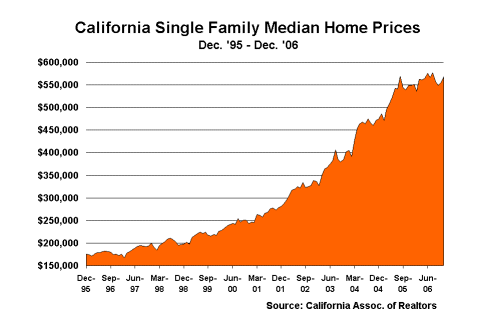

|
| weblog/wEssays archives | home | |
|
Brittleness and Risk, or, Hedge Funds As Rats (January 31, 2007)  Another way to think about brittleness and resiliency is to look at risk. A classic
example is forest fires. In the normal cycle of events, dry underbrush and other material
accumulates on the forest floor, becoming the fuel for a fire which burns the dried leaves and branches,
fertilizing the soil with the ashes and setting the stage for regrowth.
Another way to think about brittleness and resiliency is to look at risk. A classic
example is forest fires. In the normal cycle of events, dry underbrush and other material
accumulates on the forest floor, becoming the fuel for a fire which burns the dried leaves and branches,
fertilizing the soil with the ashes and setting the stage for regrowth.
Every so often, various conditions lead to a period without smaller fires, building up enough fuel for a large conflagration. These larger events tend to obey what's known as a power law: the more infrequent they are, the larger they are (and vice versa). Here is an explanation by Jim Sloman: In fact, they found that the size of earthquakes followed a law known to mathematicians as a power law. This law, now known as the Gutenberg-Richter Law, states that when you double the energy of an earthquake it happens four times less frequently.So what happens when authorities stamp out all small forest fires? They create the perfect conditions for a gigantic conflagration. The flaw is the old forest management policy of suppressing all forest fires was revealed when a huge uncontrollable fire swept through Yellowstone National Park some years ago. In other words: a system which allows occasional fires is resilient, while one which suppresses all small fires guarantees a giant conflagration. In financial terms, this "normal cycle" of growth, small fires and regrowth is "the business cycle" in which credit and business expand, eventually reaching an unsustainable level (high inventories, too much debt and capacity, etc.) Businesses go bankrupt, defaulting on credit, people save rather than borrow, and capital is accumulated for the next cycle of investment and borrowing.  Consider the above chart of the Nasdaq dot-com era bubble. Fed Chairman Greenspan
famously warned that there seemed to be an awful lot of dry underbrush accumulating
in the stock market back in 1996, but the nervous swoon which greeted his observation
soon passed, and the glorious euphoria of "free market forces at work" resumed, leading to
a peak of over 5,000 in March 2000.
Consider the above chart of the Nasdaq dot-com era bubble. Fed Chairman Greenspan
famously warned that there seemed to be an awful lot of dry underbrush accumulating
in the stock market back in 1996, but the nervous swoon which greeted his observation
soon passed, and the glorious euphoria of "free market forces at work" resumed, leading to
a peak of over 5,000 in March 2000.
How many analysts and pundits recognized the tremendous risk at the height of the bubble? Very few. Various Cassandras had been warning of rising risk for years, but their paltry investment returns only seemed to prove they didn't know what they were talking about. But like a rubber band being stretched ever farther--or a forest accumulating dry brush for years on end--an "event" was inevitable. Here we have a chart of housing prices in California. Hmm. Anyone else see an accumulation of dry tinder awaiting a lightning strike? There is another analogy for this notion of risk: a grain ship over-run with rats. Let's say there are virtually no controls on the population of the rats, and as a result they proliferate at an astonishing rate, engorging themselves on the seemingly limitless supply of grain. Alas, as the population explodes, the competition for the remaining grain increases. As the winners consume the last of the grain, the entire ship's population is doomed to starvation. A once-stable population explodes beyond its means, and then collapses. Hmm. Now let's substitute hedge funds for the rats, liquidity for grain, and competition for "alpha" (gains in excess of the broad market). Scroll back down to Monday's entry and take a look at the rise in derivatives. Does it remind you of Nasdaq's final rise? Perhaps it should. And what happened to Nasdaq in the 2.5 years following the peak? Collapse. Just to extend the analogy: there are only about 10,000 tradable stocks in the investment universe, and it's estimated there are 9,000+ hedge funds--the exact number is unknown due to lax oversight. One hedge fund for every public company. Does anyone else think the rats are approaching the last bags of grain? For more on this subject and a wide array of other topics, please visit my weblog. copyright © 2007 Charles Hugh Smith. All rights reserved in all media. I would be honored if you linked this wEssay to your site, or printed a copy for your own use. |
||
| weblog/wEssays | home |